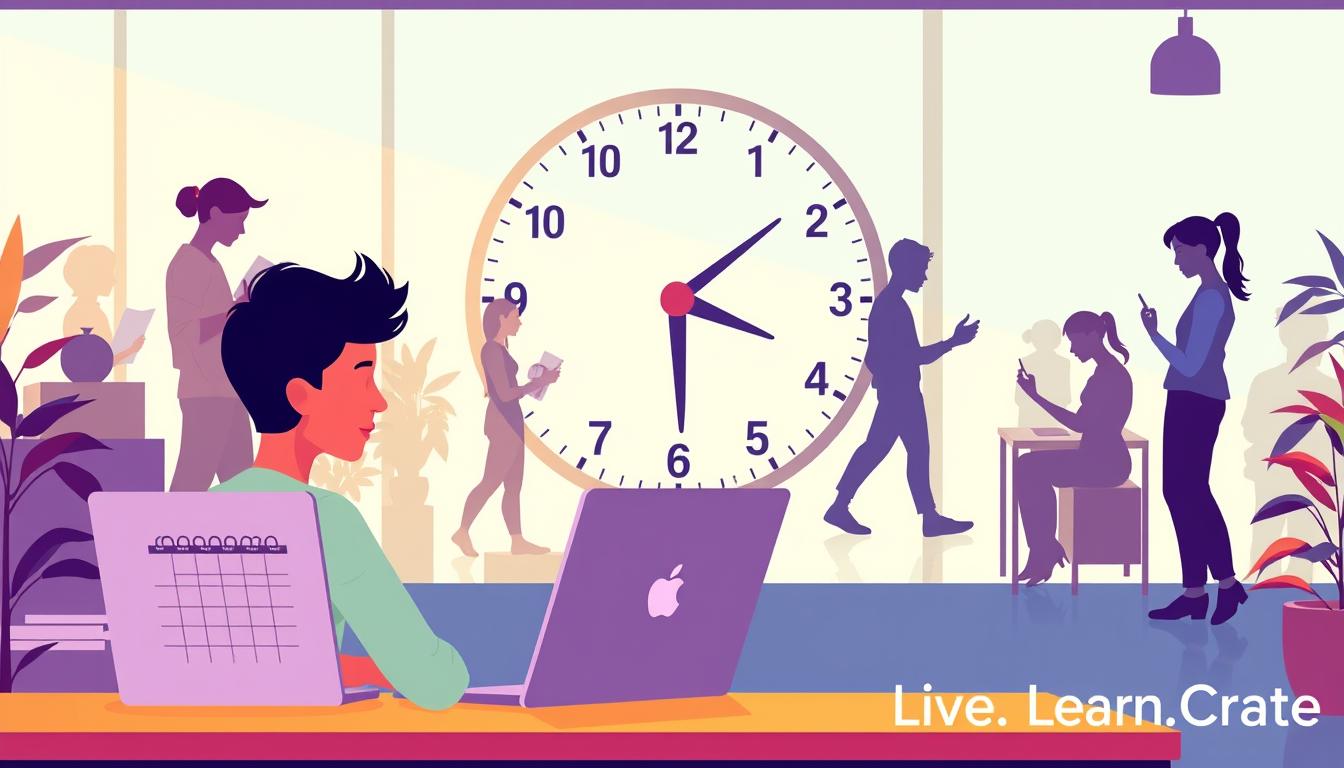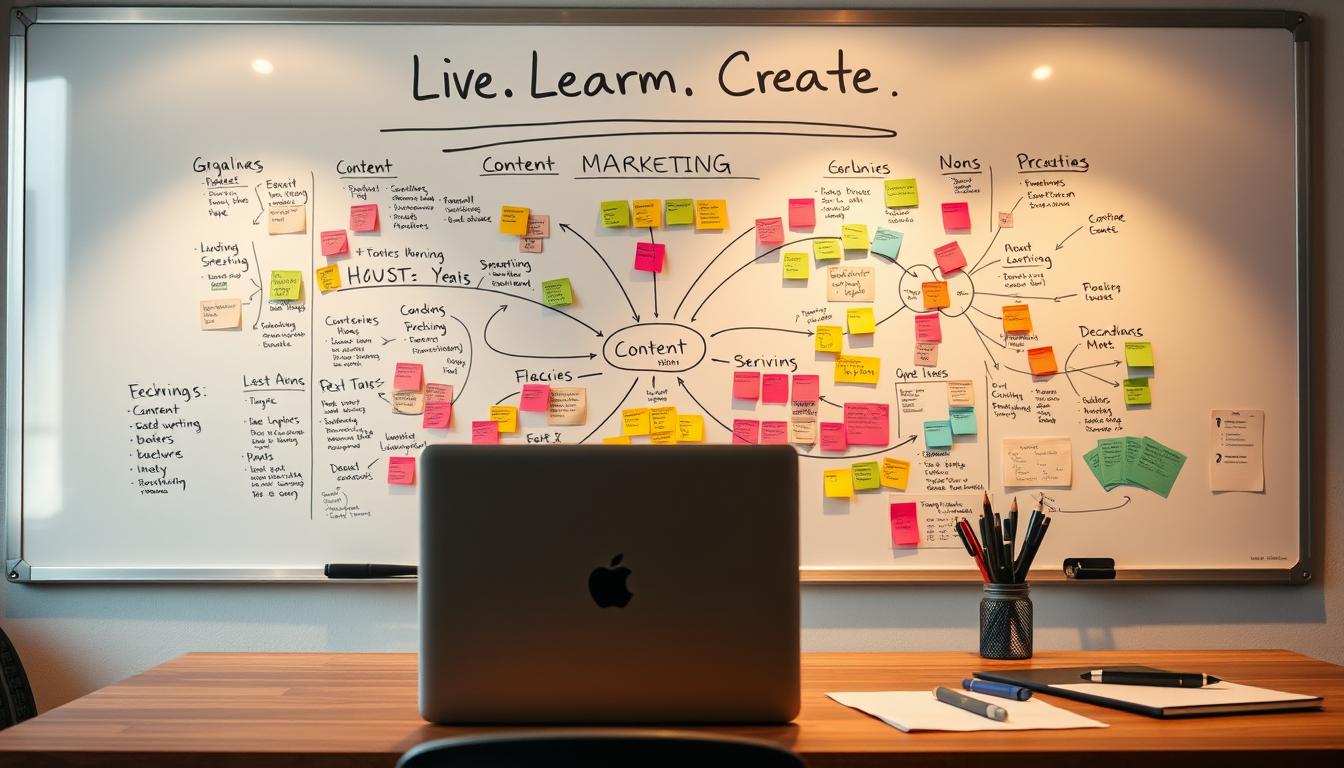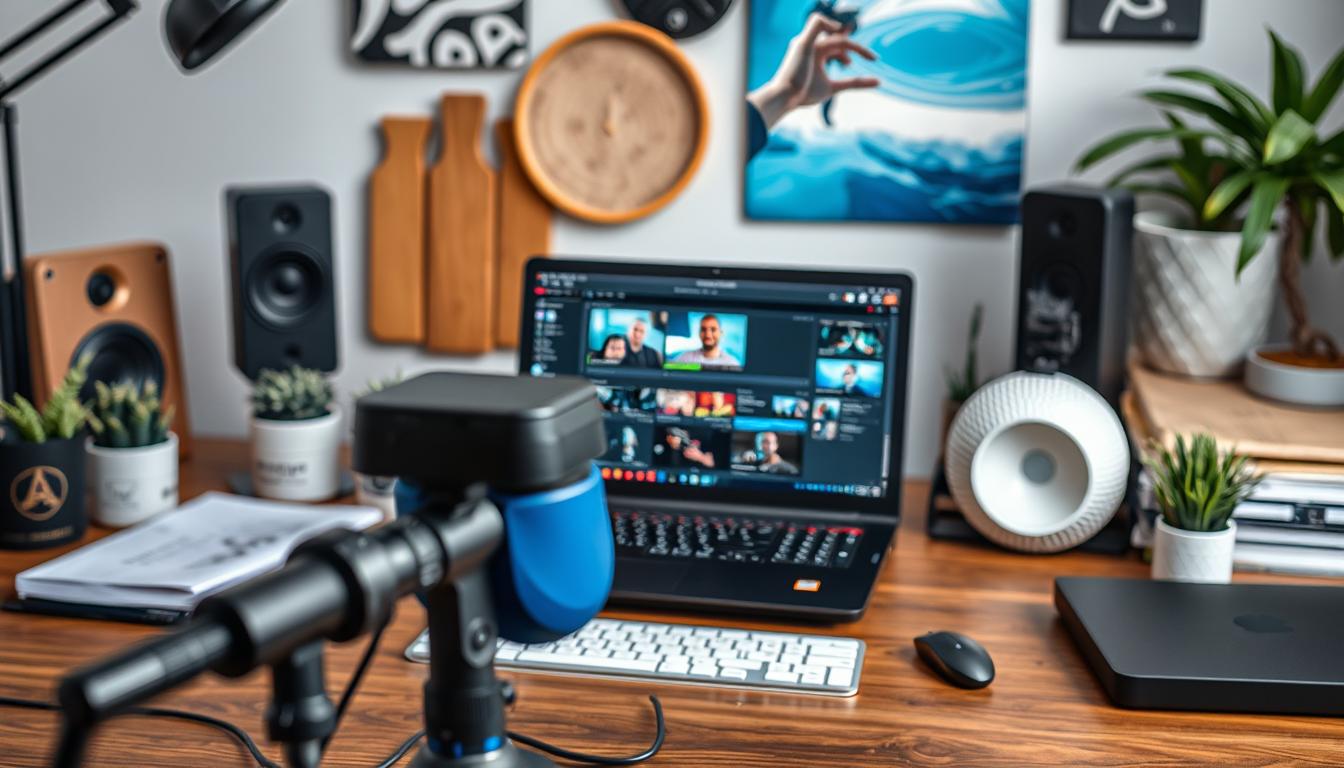“You don’t have to be great to start, but you have to start to be great.” – Zig Ziglar. Starting a task can be tough. But the 5-minute rule helps you overcome procrastination and increase your productivity.
The 5-minute rule is a simple yet effective method. It helps you start tasks you’ve been delaying. By committing just 5 minutes, you can gain momentum and move closer to your goals.
As you work to stop procrastinating, you might look for tools and resources to help. Amazon offers products related to effective time management and staying organized.
Key Takeaways
- Understand the 5-minute rule and its benefits
- Learn how to apply the 5-minute rule to your daily tasks
- Discover tools and resources to support your productivity journey
- Explore products on Amazon that can aid in time management
- Develop a strategy to overcome procrastination and achieve your goals
Understanding Procrastination: Why We Delay Action
Procrastination can really slow us down, but knowing why we do it is the first step to change. It’s not just about being lazy. It’s often a mix of psychological factors.
To beat procrastination, find out why you’re delaying. Common reasons include fear of failure, wanting everything to be perfect, and lacking motivation. Once you know why, you can start to fix it.
Common Triggers of Procrastination
Knowing what makes you procrastinate is key to changing. Some common reasons are:
- Fear of failure: The fear of not meeting expectations can cause you to delay tasks.
- Perfectionism: Setting unrealistically high standards can lead to procrastination.
- Lack of motivation: Without a clear reason to start a task, it’s easy to put it off.
By knowing these reasons, you can start to find ways to overcome them. For example, breaking big tasks into smaller ones can help you feel less overwhelmed.
Psychological Effects of Procrastination
Procrastination can really mess with your mind, making you feel stressed and anxious. You might feel relieved at first, but then you’ll feel guilty and regretful.
The table below shows how procrastination affects your mind:
| Effect | Description |
|---|---|
| Increased Stress | Delaying tasks can lead to last-minute rushes, increasing stress levels. |
| Anxiety | The weight of unfinished tasks can cause significant anxiety. |
| Guilt and Regret | Putting off tasks can lead to feelings of guilt and regret over lost opportunities. |
Understanding these effects can help you fight them. Using effective time management like the 5-minute rule can help you stay focused and boost your productivity.
What is the 5-Minute Rule?
Starting a task can be tough. That’s why the 5-minute rule is so helpful. It’s a time management strategy to beat procrastination and improve productivity at work.

Definition and Origin
The 5-minute rule is simple: work on a task for just 5 minutes. Often, the hardest part is starting. After 5 minutes, you’ll find it easier to keep going.
This rule isn’t from one person, but it’s based on starting small leading to big results. By spending a little time on a task, you build momentum and overcome barriers to action.
How It Works
The 5-minute rule is easy to use: commit to a task for 5 minutes. It could be organizing your desk or making a call you’ve been avoiding. The goal is to make a small commitment that’s hard to say no to.
After 5 minutes, you might want to keep going. This is because the initial resistance is gone, and you’re in a flow state. The 5-minute rule helps you improve productivity at work and tackle bigger tasks.
Adding the 5-minute rule to your daily routine can improve your time management strategies and productivity. It’s a simple, effective way to make progress on tasks you might delay.
Benefits of Using the 5-Minute Rule
The 5-minute rule is a simple yet powerful tool to beat procrastination and boost productivity. By spending just a few minutes on a task, you can make big strides and feel a sense of achievement.
Boosting Productivity and Focus
One key benefit of the 5-minute rule is its power to boost productivity and enhance focus. Committing to work on a task for just 5 minutes helps you get past the initial hurdle. This method works well when paired with productivity tools that keep you organized and on track.
As you keep using the 5-minute rule, you’ll find it easier to stay focused and make steady progress. This can lead to more productivity and a better sense of control over your work.
Reducing Overwhelm and Anxiety
The 5-minute rule also helps reduce feelings of overwhelm and anxiety by breaking down big tasks into smaller ones. When faced with a huge task, it’s easy to feel overwhelmed and unsure of where to start. The 5-minute rule gives you a clear starting point, allowing you to make progress without feeling overwhelmed.
By adding the 5-minute rule to your time management techniques, you can better prioritize your tasks and make steady progress. This can lead to less stress and a calmer state of mind, as you tackle your tasks one step at a time.
How to Implement the 5-Minute Rule
The 5-minute rule is a simple yet powerful tool for overcoming procrastination and improving time management. By dedicating just five minutes to a task, you can build momentum and make significant progress on tasks you’ve been putting off.
Tips for Getting Started
To effectively implement the 5-minute rule, start by creating a conducive work environment. This means minimizing distractions and setting up your workspace to promote focus. Here are a few tips to get you started:
- Clear your workspace of clutter to help you concentrate.
- Turn off notifications on your phone or computer to avoid interruptions.
- Use a timer to keep yourself on track and maintain the five-minute commitment.
By following these tips, you’ll be able to increase your productivity and make the most of the 5-minute rule.

Choosing the Right Tasks to Try It On
Not all tasks are suitable for the 5-minute rule. To get the most out of this technique, choose tasks that are either quick to complete or have a significant impact when started. Examples include:
- Organizing a small part of your workspace.
- Starting a new project by outlining the initial steps.
- Making a to-do list for the day or week.
By applying the 5-minute rule to the right tasks, you’ll develop valuable time management skills and see an improvement in your overall productivity.
| Task Type | Example Tasks | Benefits |
|---|---|---|
| Quick Tasks | Organizing a small area, responding to a simple email | Immediate sense of accomplishment, reduced clutter |
| High-Impact Tasks | Starting a new project, planning a day’s schedule | Long-term benefits, improved time management |
Overcoming Resistance with the 5-Minute Rule
We all face resistance when starting something new. The 5-minute rule is a simple way to get past it. Resistance is normal when starting something new. But, by spending just 5 minutes, you can overcome it.
Identifying Your Resistance Points
First, figure out where your resistance comes from. Ask yourself, “What am I afraid of?” Is it the task or the outcome? Thinking about this can help you find your resistance points. As Mark Twain said,
“The secret of getting ahead is getting started.”
Knowing your resistance is the first step to moving forward.
Strategies to Push Through
After finding your resistance points, it’s time to move past them. Here are some ways to do it:
- Break down big tasks into smaller parts. This makes it easier to spend 5 minutes on them.
- Create a good environment for work. This helps you stay focused and avoid distractions.
- Use positive words to encourage yourself. This helps you take that first 5-minute step.
Using these strategies and the 5-minute rule will improve your productivity and time management. As you get better at starting tasks, you’ll feel less resistance. You’ll also manage your time better.
As Brian Tracy said,
“You don’t have to be great to start, but you have to start to be great.”
The 5-minute rule is your first step to being more productive.
Establishing a Routine Using the 5-Minute Rule
Creating a daily routine with the 5-minute rule can change your productivity game. This simple technique boosts your time management skills. You’ll get more done in less time.
Let’s dive into making a daily schedule that fits you. Effective time management means prioritizing tasks and using your time well. Here are some time management tips for your daily schedule:
- Begin by listing your tasks in order of importance.
- Set specific times for each task, leaving room for surprises.
- Apply the 5-minute rule to start tasks you’ve been delaying.
Designing Your Daily Schedule
A good daily schedule balances long-term goals with short-term tasks. To achieve this balance, consider these steps:
- Break down big goals into smaller, doable tasks.
- Focus on tasks that help you reach your long-term goals.
- Use the 5-minute rule to make daily progress on these tasks.
For example, if you want to write a book, aim to write 500 words daily. Start with just 5 minutes using the 5-minute rule. Often, you’ll keep going after the initial 5 minutes.

Long-Term Goals vs. Short-Term Tasks
It’s key to know the difference between long-term goals and short-term tasks for effective time management. Long-term goals guide you, while short-term tasks are the steps to get there.
Here’s a table to show the difference:
| Task Type | Example | Time Frame |
|---|---|---|
| Long-Term Goal | Completing a professional certification | Several months to a year |
| Short-Term Task | Studying for 30 minutes each day | Daily |
By mixing long-term goals with short-term tasks and using the 5-minute rule, you can boost your productivity. This helps you reach your goals.
The Role of Breaks in Time Management
Taking regular breaks is key to good time management. It lets you recharge and refocus. By adding breaks to your schedule, you can work at a steady pace and boost your productivity.
Importance of Short Breaks for Efficiency
Short breaks can greatly boost your productivity. They give you a chance to rest and recharge. Working without breaks can make you lose focus and efficiency.
Short breaks help you:
- Reduce mental fatigue
- Improve concentration
- Enhance creativity
How Breaks Enhance Focus
Breaks help you stay focused by giving you rest. After a break, you’ll tackle your task with more energy and clarity. This is very helpful for complex tasks that need a lot of concentration.
To get the most from breaks, use time management strategies with regular rest times. This keeps you on track and productive during your work sessions.
Tools and Apps for Enhancing Productivity
To boost productivity at work, using the right tools and techniques is key. Technology has brought many apps and tools to help with time management and staying focused.
Recommended Apps for Time Management
There are many apps to help manage your time better. Here are some top picks:
- Trello: A project management tool that uses boards, lists, and cards to organize tasks.
- RescueTime: An app that tracks how you spend your time on your computer or mobile device.
- Focus@Will: A music service that provides background music to help you concentrate.
- Todoist: A task management tool that lets you create and manage your to-do lists.
- Evernote: A note-taking app that allows you to capture, organize, and store information across multiple devices.
Amazon offers a wide range of these tools. They can help you apply the 5-minute rule and boost your productivity.
Using Timers Effectively with the 5-Minute Rule
Timers are simple yet powerful tools for boosting productivity. They work well with the 5-minute rule to keep you focused and moving forward.
Here’s a look at different timer techniques:
| Timer Technique | Description | Benefits |
|---|---|---|
| Pomodoro Technique | Work for 25 minutes, then take a 5-minute break. | Enhances focus, reduces burnout. |
| 5-Minute Rule | Commit to working on a task for just 5 minutes. | Overcomes initial resistance, builds momentum. |
| Time Blocking | Schedule fixed, uninterrupted blocks of time for tasks. | Improves time estimation, reduces distractions. |

Real-Life Success Stories
Many people have used the 5-minute rule to get more done. They spend just a few minutes each day on tasks. This helps them beat procrastination and reach their goals.
Case Studies of Productivity Boost
Studies show the 5-minute rule really works. For example, a freelance writer started her day with five minutes of planning. This led to a big increase in productivity for her.
- A student used the 5-minute rule to study for exams, resulting in improved grades.
- A professional used it to tackle big projects, breaking them down into smaller tasks.
These stories show how the 5-minute rule is a great time management technique.
Testimonials from Users
Many people have shared their success with the 5-minute rule. Here are a few:
“The 5-minute rule has changed my daily routine. I now start my day with a sense of accomplishment, and it has greatly increased my productivity.” – Emily, Marketing Manager
“I was skeptical at first, but dedicating just five minutes to my tasks has made a huge difference. It’s a simple yet effective time management technique.” – David, Entrepreneur
These stories show how the 5-minute rule helps people increase productivity and reach their goals.
By using the 5-minute rule and other time management techniques, people can see a big boost in productivity. They can make real progress towards their goals.
Common Mistakes to Avoid
To make the most of the 5-minute rule, it’s key to know what not to do. As you use this method every day, knowing common mistakes helps you stay focused. It also helps you improve your effective time management skills.
Misconceptions About the 5-Minute Rule
Many think the 5-minute rule works for everything. But, it really depends on the task and your situation. For example, big tasks or ones with big risks might not fit the 5-minute rule.
Another mistake is thinking the 5-minute rule solves all procrastination problems. It’s a great tool, but using it alone won’t solve everything. You need other strategies too.

When the 5-Minute Rule May Not Work
There are times when the 5-minute rule doesn’t cut it. For instance, very complex tasks or ones needing lots of resources can’t be started with just 5 minutes.
| Scenario | Why 5-Minute Rule May Not Work | Alternative Approach |
|---|---|---|
| Complex tasks | Requires more time to understand and plan | Break down into smaller, manageable tasks |
| High-stakes tasks | May require more preparation and caution | Use a more detailed planning approach |
| Tasks requiring significant resources | 5 minutes may not be enough to make progress | Allocate a larger block of time |
Knowing when to adjust your approach helps you manage time better. This way, you can reach your goals more effectively.
Additional Techniques to Combat Procrastination
There are more ways to beat procrastination than just the 5-minute rule. While it’s great for starting, adding other methods can make you even more productive. These techniques help you manage your time better and get more done.
The Pomodoro Technique Explained
The Pomodoro Technique was created by Francesco Cirillo in the late 1980s. It works by focusing on tasks for 25 minutes, called “Pomodoros.” After each cycle, you take a 5-minute break. After four cycles, you get a longer break of 15-30 minutes.
Key Benefits of the Pomodoro Technique:
- Enhanced focus and concentration
- Increased productivity through regular breaks
- Better time estimation and planning
- Reduced burnout by providing regular rest periods
Setting SMART Goals for Success
SMART (Specific, Measurable, Achievable, Relevant, Time-bound) goals are also effective against procrastination. They help you set clear, achievable targets. This makes it easier to plan and reach your goals.
Here’s how to set SMART goals:
| Criteria | Description | Example |
|---|---|---|
| Specific | Clearly define what you want to achieve | Write a 2,000-word report |
| Measurable | Quantify your goal to track progress | Complete 500 words daily |
| Achievable | Ensure the goal is realistic based on your resources | Allocate 2 hours daily for writing |
| Relevant | Align your goal with your broader objectives | Improve project visibility through the report |
| Time-bound | Set a specific deadline for completion | Finish the report within 4 days |
Using the 5-minute rule with the Pomodoro Technique and SMART goals can create a strong productivity system. Try out these methods to find what works best for you. With the right combination, your productivity will increase significantly.
Conclusion: Start Your Journey to Better Time Management Today
The 5-minute rule is a simple yet powerful way to beat procrastination and boost productivity. By spending just a few minutes each day on a task, you can start making progress. This small step can lead to big changes over time.
Key Takeaways
The 5-minute rule is more than a quick fix. It’s a change in how you think. By using it every day, you’ll find it easier to handle tough tasks. You’ll also get better at managing your time. For more tips and strategies, check out the many resources out there.
Taking the First Step
Now that you know about the 5-minute rule, it’s time to try it. Pick a task you’ve been avoiding and work on it for 5 minutes. As you get used to it, you can do more and tackle harder tasks. To help you stay on track, look into productivity tools on Amazon.
FAQ
What is the 5-minute rule and how does it help with productivity?
The 5-minute rule is a simple technique. It involves working on a task for just 5 minutes. This makes starting tasks easier, and you might find it easier to keep going after the first 5 minutes.
How can I effectively implement the 5-minute rule in my daily routine?
To use the 5-minute rule, pick tasks you’ve been avoiding. Make sure your work area is good and free from distractions. You can also use apps to help you stay focused.
What are some common triggers of procrastination that the 5-minute rule can help overcome?
Procrastination can be caused by fear of failure, wanting to be perfect, or lack of motivation. The 5-minute rule helps by breaking tasks into smaller parts. It makes starting easier.
Can the 5-minute rule be used in conjunction with other productivity techniques?
Yes, you can use the 5-minute rule with other methods like the Pomodoro Technique and SMART goals. This can improve your productivity and time management even more.
How can I find productivity tools and resources on Amazon to support my journey?
Look for productivity and time management items on Amazon. You can find planners, apps, and tools to help you stay organized and focused.
What are some common mistakes to avoid when using the 5-minute rule?
Avoid thinking the 5-minute rule works for everything. Also, don’t ignore when it might not be right. Knowing these can help you manage your time better.
How can I maintain a sustainable work pace using the 5-minute rule and other time management techniques?
To keep a good work pace, take regular breaks and prioritize tasks. Avoid doing too many things at once. Use the 5-minute rule for breaks to stay refreshed.
Are there any recommended productivity apps and tools that can be used with the 5-minute rule?
Yes, many productivity apps and tools work well with the 5-minute rule. You can find timers and task management software on Amazon and other online places.
Transform your home into a more peaceful and mindful sanctuary. Creating a Zen-inspired home environment is a core part of the “Live.Learn.Create” theme, focusing on peace, mindfulness, and a clutter-free space. Here is a curated list of Zen home items.
The Zen Essentials
These items are the building blocks of a calm, intentional living space.
- Candles & Scents:
- Scented Candles: Look for calming, natural scents like sandalwood, lavender, white tea, or bergamot. Choose candles made with soy or beeswax for a clean burn.
- Essential Oil Diffusers: A minimalist, sleek diffuser made of bamboo, ceramic, or glass.
- Essential Oil Sets: Look for blends specifically for relaxation, focus, or sleep.
- Incense & Burners: Natural incense sticks (e.g., palo santo, sage) with a simple, elegant burner.
The Zen Decor
This is about incorporating natural elements and simple design.
- Natural Materials:
- Wood or Bamboo Trays: For organizing candles, stones, or other small items.
- Ceramic Vases: Simple, unglazed ceramic vases in neutral colors like white, beige, or gray.
- Minimalist Art: Simple line drawings, abstract prints, or nature-inspired artwork.
- Hand-Carved Stone Coasters: Or other small stone sculptures.
- Textiles:
- Linen or Cotton Throws: A soft, neutral-colored throw blanket to add warmth.
- Jute or Sisal Rugs: These add natural texture and grounding to a space.
- Meditation Cushions (Zafu) & Mats (Zabuton): These provide comfort for meditation and add a serene touch to a room.
The Zen Ambiance
These items help create a peaceful sensory experience.
- Lighting:
- Himalayan Salt Lamps: These provide a warm, soft glow.
- Japanese-style Paper Lanterns: For a soft, diffused light source.
- Dimmable Smart Bulbs: To easily control the warmth and brightness of your lighting.
- Sound:
- Tabletop Water Fountains: The gentle sound of running water is incredibly calming.
- Wind Chimes: Made from natural materials like bamboo or metal for a soft sound.
- Bluetooth Speakers: Small, aesthetically pleasing speakers for playing ambient or meditation music.
- Nature:
- Bonsai Trees or Air Plants: Low-maintenance indoor plants that bring life and a touch of nature indoors.
- Zen Gardens: A small, tabletop sand garden with a rake and stones for a meditative ritual.
- Decorative Rocks & Pebbles: For bowls or as a decorative element.
Best Sellers https://amzn.to/3Vet1tI
New Releases https://amzn.to/4mwLjTi
Amazon Movers & Shakers https://amzn.to/4fPsZlP
Mindfulness Coloring Books https://amzn.to/4fQ0wMx
Personal Growth Coloring Books https://amzn.to/4lJeRf0
Health & Wellness https://amzn.to/4oRt24C
Zen Home Decor https://amzn.to/3VeA3i6
Zen Garden Decor https://amzn.to/4mXjT8D
Zen Garden https://amzn.to/3HQTVVB
- Mindfulness & Meditation:
- Physical Wellness:
- Habit & Productivity Tools:
- Books:
- Best-selling personal development books (Mindset, The 7 Habits of Highly Effective People, The Subtle Art of Not Giving a F*ck)
- Books on a variety of skills (coding, photography, writing.)
- Educational Gadgets:
- Smart pens that digitize notes (e.g., Rocketbook)
- Portable scanners for digitizing documents
- Laptops, tablets, and accessories
Create (Creativity, Innovation, Projects)
These products cater to your creative side, whether you are a artists, writer, or DIY enthusiasts.
- Creative Supplies:
- Adult coloring books or “paint-by-sticker” books
- Craft kits (e.g., candle-making, pottery, embroidery)
- Digital Creation Tools:
- General Inspiration & Making:




















